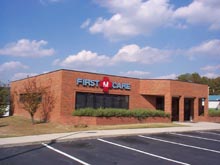
|
|
|
|
|
|
|
|
|
|
 |
|
|
| > APPLICATIONS | ||
| First Care, Inc. | ||
|
First Care is a privately owned urgent care center and general
practice with one location in Columbia, South Carolina. General
bookkeeping and patient visit information was handled with software
The model consisted of a description of the major drivers of activity: patients, average visits per patient per year, and average charges per visit. Separate modules determined much of the input data necessary. Variable costs were tied to appropriate activity levels so different scenarios could be evaluated by changing a few critical variables. A set of measures of performance was developed so that a change in a critical variable would immediately show a consequent change in related measures. A base case was developed based on the data from the prior planning period. Any calculated ratios or efficiencies from the past period could then be changed for the budget and the resulting effect computed. In this way the budget was based on factors that could be influenced and improved. The managing doctor could go through the model systematically and change any inputs in accord with his or her perceptions of what was desired during the budget period. The model thus was a blue print of the business. Because the model was easily changed, any changes in patient mix, costs or charges could easily be reflected in the model. One important benefit of model development was the clarification of how to evaluate the degree to which the practice was based on emergency care. The perception was that the percent of total visits that were return visits (RV’s) was the correct measure to use. Because the model was based on patient activity and not visits, there arose the need for a distribution of patients by number of visits per year. This distribution indicated that the percent of patients who came more than once was a better measure. It was quickly realized that the RV percent was skewed, since some individual patients generated as many as fifty-two RV’s a year (e.g. allergy shots). The percent of patients who came only once reflected the degree to which the practice was vulnerable to new competition. Integrated Planning Models have a unique ability to clarify the meaning of numbers and show which numbers are necessary to understand the level of an organization’s success. IMS Quantum specializes in providing management with planning and budgeting tools that show where vulnerabilities and opportunities lie. |
||

 specifically designed for the needs of the small to medium-sized
medical practice. Budgeting and planning was done by manual methods
as the need arose. In November of 1989, IMS Quantum (then Integrated
Management Systems, Inc.) was engaged to implement a number of
improvements to the information system as well as to develop an
Integrated Planning Model for the practice as a whole.
specifically designed for the needs of the small to medium-sized
medical practice. Budgeting and planning was done by manual methods
as the need arose. In November of 1989, IMS Quantum (then Integrated
Management Systems, Inc.) was engaged to implement a number of
improvements to the information system as well as to develop an
Integrated Planning Model for the practice as a whole.